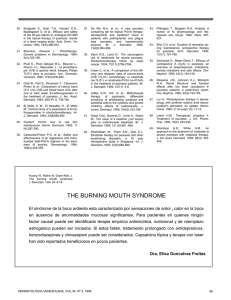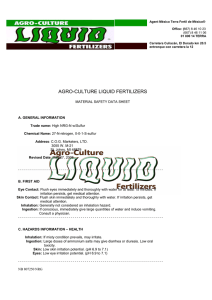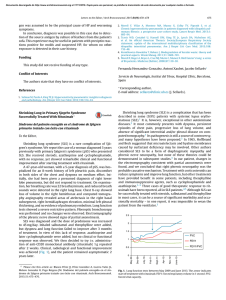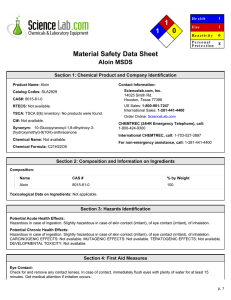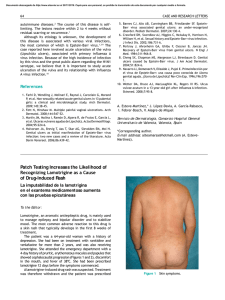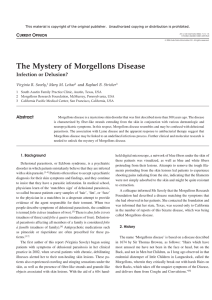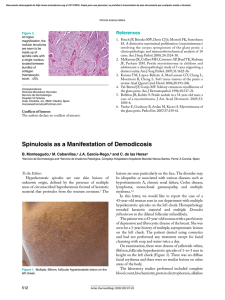Detergents: Surfactants, Properties & Skin Effects
Anuncio
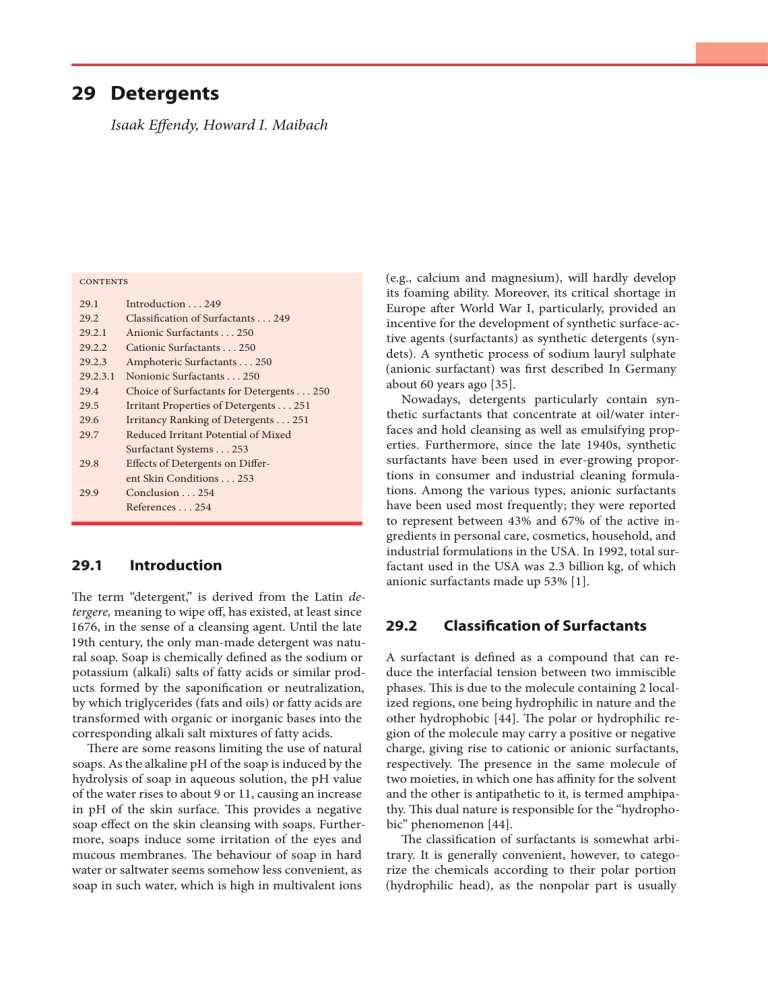
249 29 Detergents Isaak Effendy, Howard I. Maibach Contents 29.1 29.2 29.2.1 29.2.2 29.2.3 29.2.3.1 29.4 29.5 29.6 29.7 29.8 29.9 29.1 Introduction . . . 249 Classification of Surfactants . . . 249 Anionic Surfactants . . . 250 Cationic Surfactants . . . 250 Amphoteric Surfactants . . . 250 Nonionic Surfactants . . . 250 Choice of Surfactants for Detergents . . . 250 Irritant Properties of Detergents . . . 251 Irritancy Ranking of Detergents . . . 251 Reduced Irritant Potential of Mixed Surfactant Systems . . . 253 Effects of Detergents on Different Skin Conditions . . . 253 Conclusion . . . 254 References . . . 254 Introduction The term “detergent,” is derived from the Latin detergere, meaning to wipe off, has existed, at least since 1676, in the sense of a cleansing agent. Until the late 19th century, the only man-made detergent was natural soap. Soap is chemically defined as the sodium or potassium (alkali) salts of fatty acids or similar products formed by the saponification or neutralization, by which triglycerides (fats and oils) or fatty acids are transformed with organic or inorganic bases into the corresponding alkali salt mixtures of fatty acids. There are some reasons limiting the use of natural soaps. As the alkaline pH of the soap is induced by the hydrolysis of soap in aqueous solution, the pH value of the water rises to about 9 or 11, causing an increase in pH of the skin surface. This provides a negative soap effect on the skin cleansing with soaps. Furthermore, soaps induce some irritation of the eyes and mucous membranes. The behaviour of soap in hard water or saltwater seems somehow less convenient, as soap in such water, which is high in multivalent ions (e.g., calcium and magnesium), will hardly develop its foaming ability. Moreover, its critical shortage in Europe after World War I, particularly, provided an incentive for the development of synthetic surface-active agents (surfactants) as synthetic detergents (syndets). A synthetic process of sodium lauryl sulphate (anionic surfactant) was first described In Germany about 60 years ago [35]. Nowadays, detergents particularly contain synthetic surfactants that concentrate at oil/water interfaces and hold cleansing as well as emulsifying properties. Furthermore, since the late 1940s, synthetic surfactants have been used in ever-growing proportions in consumer and industrial cleaning formulations. Among the various types, anionic surfactants have been used most frequently; they were reported to represent between 43% and 67% of the active ingredients in personal care, cosmetics, household, and industrial formulations in the USA. In 1992, total surfactant used in the USA was 2.3 billion kg, of which anionic surfactants made up 53% [1]. 29.2 Classification of Surfactants A surfactant is defined as a compound that can reduce the interfacial tension between two immiscible phases. This is due to the molecule containing 2 localized regions, one being hydrophilic in nature and the other hydrophobic [44]. The polar or hydrophilic region of the molecule may carry a positive or negative charge, giving rise to cationic or anionic surfactants, respectively. The presence in the same molecule of two moieties, in which one has affinity for the solvent and the other is antipathetic to it, is termed amphipathy. This dual nature is responsible for the “hydrophobic” phenomenon [44]. The classification of surfactants is somewhat arbitrary. It is generally convenient, however, to categorize the chemicals according to their polar portion (hydrophilic head), as the nonpolar part is usually 250 Isaak Effendy, Howard I. Maibach Table 1. Classification of surfactants and their use Modified from [8]. Type of surfactant Frequently used surfactants Anionic Sodium lauryl sulphate, sodium lauryl Detergent, emulsifying, soluether sulphate, TEA-lauryl ether sulphate bilizing and wetting agent Cationic Quaternium-15, Quaternium19, stearylalkoniumchloride Preservatives (antimicrobial agent) Amphoteric Cocoamidopropyl betaine, coco betaine, disodium cocoamphodiacetate Detergent, emulsifying agent, foam booster Nonionic Polysorbat 20, cocamide DEA, lauramide DEA Detergent, emulsifying agent, foam booster made up of alkyl or aryl groups [2, 45, 67]. The major polar groups of most synthetic surfactants are classified into four types (Table 1). 29.2.1 Anionic Surfactants The most commonly used anionic agents are those containing alkyl carboxylates, sulphonates, and sulphate ions. Those containing carboxylate ions are known as natural soaps. Soaps, however, provide the oldest anionic surfactant: a natural surfactant made by simple hydrolysis of natural materials. Many alkyl sulphates are used as detergents, but by far the most popular member of this group is sodium lauryl sulphate (SLS). Unlike soaps, SLS is compatible with dilute acid and with calcium and magnesium ions. The lower-chain-length compounds, around C12, have better wetting ability, whereas the higher members (C16–C20) have better detergent properties [45]. SLS has been reported to exhibit in vitro and in vivo antibacterial effects [56]. 29.2.2 Cationic Surfactants Many long-chain cations, such as amine salts and quaternary ammonium salts, are used as surfactants when dissolved in water; however, their use is generally limited to that of antimicrobial preservatives because of their bactericidal activity [2, 67]. 29.2.3 Amphoteric Surfactants Amphoteric agents possess at least one anionic and one cationic group in its molecule. They have the Application detergent properties of anionic surfactants and the disinfectant properties of cationic surfactants. Their activity depends on the pH of the media in which they are used. Balanced amphoteric surfactants are reputed to be nonirritant to the eyes and skin and have therefore been used in so-called baby shampoos [44]. The most often used amphoterics are betaines, sulfobetaines, imidazolinium derivatives, and alkyl aminoacids [5] 29.2.3.1 Nonionic Surfactants Nonionic surfactants have the advantage over ionic surfactants in that they are compatible with all other types of surfactants and their properties are minimally affected by pH. Moreover, they are generally less irritant than anionic or cationic surfactants. Nonionic surfactants are used as emulsifiers and solubilizing and wetting agents. They have applications in the food, cosmetic, paint, pesticide, and textile industries [44]. 29.4 Choice of Surfactants for Detergents In Europe, a blend of alkyl sulphates and alkyl sulfosuccinates has mostly been employed. The pH value of the bar ranges between 5.5 to 7.0; however, in recent years, the use of sodium cocoyl isethionate has been increased in terms of producing mild bars following the American trend of skin cleansers. In the USA, the preferred concept of “mild” skin cleansers makes the expensive sodium cocoyl isethionate the main surfactant used. To reduce the final cost of the formulation, the corresponding surfactant 29 Detergents blend includes about 30% fatty acid and fatty acid soap [49]. This, in turn, is responsible for the dull and somewhat slimy appearance of certain products. Other main surfactants used in the USA are sodium cocomonoglyceride sulphate and sodium cocoglyceryl ether sulfonate [14]. In Japan, acyl glutamate is the major surfactant used in some of the sophisticated, expensive skin cleansers. In contrast, in other Asian countries, natural sodium soaps still provide the main cleanser, as high-cost cleanser bars are hardly acceptable to the consumer. The cleaning and lathering properties, plasticity, and skin compatibility will definitely depend on the surfactants and the proportions in which they are used. Alkyl sulphate and sulfosuccinate blends seem to have the highest cleansing properties, followed by acyl glutamate and triethanolamine soaps, whereas natural sodium soaps were ranked last [6, 14, 51]. Certain surfactants have a strong odor due to their origins, (e.g., fatty acid from coconut). To overcome such an odor, highly concentrated fragrances are often required for the formulation. This, in turn, may increase the risk for contact sensitivity to fragrance for the consumer. In reality, the choice of the surfactants used as detergents may, indeed, not necessarily follow the basic aim of cleansing and washing, but rather consumer trend, which has been favored, advertised by the manufacturers themselves in terms of creating new products; however, at the very least, a printed declaration of the ingredients used and hotline numbers for information regarding the product may be helpful for consumers. 29.5 Irritant Properties of Detergents Surfactants used as detergents may cause skin irritation. The mechanisms of surfactant-induced irritant dermatitis are not yet fully understood [31]. It has been reported that the effects of surfactants depend on both concentration and surfactant-lipid molar ratios. At low concentrations, surfactants can disrupt membranes that resulted in increased membrane permeability [22], whereas at higher concentrations (above the critical micelle concentration) surfactants cause cell lysis [42]. Thus, two opposing events, namely, interaction with the membrane and the permeant with the micelle, may be responsible for the overall effect of the surfactant on membrane permeability [57]. Anionic surfactants prove to be potent primary irritants to human and animal skin [30], and cationic surfactants are reputedly at least equally irritating [30, 48], but more cytotoxic than anionics [19, 26]. The irritation potential of nonionic surfactants is believed to be the lowest [21, 30, 60, 67]. Nevertheless, the irritancy ranking order of detergents cannot generally be made by the arbitrary classification of surfactants. Mounting data suggest that change of epidermal lipid composition, protein denaturation, epidermal cytokine release, epidermal barrier repair, and individual intrinsic factors can contribute to irritant responses [3, 38, 62, 63]. Interestingly, the pathogenesis of skin irritation seems to vary depending on the stimulus used [11, 12, 61, 65]. SLS, a widely used model irritant, has recently been shown to provoke damage to the nucleated parts of the epidermis and alterations to the lower layers of the stratum corneum (SC); however, the upper portions of the SC showed intact intercellular lipid layers that contradict the long-standing belief that surfactants damage the skin by delipidization [11]. Other investigators have suggested that the epidermal response to detergent exposure is primarily directed at restoration of barrier function [34]. Detergents are needed in everyday life; however, they provide a relevant risk factor in the development of irritant contact dermatitis. Hence, it is mandatory to search for less irritant detergents. 29.6 Irritancy Ranking of Detergents In recent years numerous in vivo and in vitro studies on the irritant potential and the irritancy ranking order of detergents have been performed (Tables 2, 3). In vivo data showed that SLS exhibited a higher irritancy than amphoteric surfactants [26, 55, 60]; however, the detergent concentrations and the measurement methods employed may influence the test outcome. SLS at a high concentration was more irritating than benzalkonium chloride (BAC), or at least equally irritating, at a low concentration [4, 60]. Conversely, at the same concentration, BAC, clinically as well as in in vitro assay, has demonstrated a higher irritant or cytotoxic potential than SLS [10, 19, 26, 37, 41]. Tupker et al. [53] have shown that different evaluation methods (visual scoring, bioengineering assessment) and exposure model (one-time occlusive test, repeated short-time occlusive, and repeated shorttime open test) can vary the outcome of irritancy testing in humans (Table 3). The concordance among the 251 252 Isaak Effendy, Howard I. Maibach Table 2. In vivo irritancy ranking of frequently used surfactants AEOS-3EO, alkyl (C12-14 average) ethoxy sulphate; BAC, benzalkonium chloride; CAPB, cocamidopropyl betaine; ISE, sodium cocoyl isethionate; LAS, linear alkyl (C12 average) benzene sulfonate; LESS, disodium laureth sulphate; PEG, polyethylene glycol; PG, propylene glycol; RMSS, disodium ricinoleamido monoethanolamido sulfosuccinate; SLES, sodium lauryl ether sulphate; SLS, sodium lauryl sulphate; SUC, disodium lauryl 3-ethoxysulfosuccinate. Modified from [8]. Irritancy ranking Irritancy test in humans Assessment References Soap >SLS >ISE >SUC One-time occlusive test Visual scoring [53] SLS >ISE >Soap >SUC Repeated short-time occlusive Visual scoring and TEWL SLS >ISE >Soap >SUC Repeated short-time open Visual scoring and TEWL SLS >SLES >CPAB >LESS >RMSS >PEG (each 1%) 2-day soap chamber test TEWL, skin reflective color (SRC/chromameter) [26] 0.5% SLS >0.5% dodecyl trimethyl ammonium bromide >potassium soap 24-hour patch test TEWL, capacitance [58b] N-alkyl sulfate C12 >C8-10 , C14-16 24-h patch test TEWL, SRC [58a] 2% SLS >2.9% LAS >7.9% PEG-20 glyceryl monotallowate 5-day repeated occlusive application test (2 times daily) Spectroscopic and visual scoring, TEWL, SRC, capacitance, skin replica [66] 7% SLS >7% CAPB >1% BAC >10% sorbitan monolaurate 24-h plastic occlusion stress test Skin surface water loss (SSWL) [4] 5% SLS >0.5% BAC >100% PG 48-h patch test Visual scoring 5% SLS >0.5% BAC >100% PG Histology SLS >cocobetaine >CAPB (each 2%) 48-h patch test TEWL [60] [55] Table 3. In vitro toxicity ranking of frequently used surfactants Commercial human skin model= human dermal fibroblasts in a collagen-gel or a nylon-mesh matrix cocultured with NHEK that have performed a stratified epidermis. CTAB, cetyltrimethylammonium bromide. Modified from [8]. Toxicity ranking In vitro test (cell culture) Assessment References BAC >SLS >between 80 Human primary keratinocytes Arachidonic acid and Interleukin-1• release, MTT (mitochondrial metabolic activity) assay [37] CTAB >SLS (at concentration: 3 g/mg) Normal human epidermal keratinocytes (NHEK) MTT assay [5b] BAC >SLS (at concentration: 1×10-5M) Normal human oral and foreskin keratinocytes MTT assay and lactate dehydrogenase (LDH) release [10] Cationic = amphoteric >anionic >nonionic surfactants NHEK, HaCaT cells and 3T3 cells Neutral red release and cell growth/protein [26] N-alkyl-sulfate C12 >C14 >C10 >C16 >8 HaCaT cells Neutral red release [59] BAC >SLS >between 20 Commercial human skin model* (Skin2) MTT assay, LDH and PGE2 release [41] 0.2% BAC >0.5% SLS >0.5% CAPB >30% PG Commercial human skin model* (Skin equivalent) MTT assay [19] 29 Detergents different exposure methods has been found to be high when evaluated by transepidermal water loss (TEWL) but not by visual scoring, implying somewhat the superiority of the bioengineering assessment; however, visual scoring seems to be the “gold standard” in everyday use. This is one of the reasons when conducting irritancy tests among the various methods that an exposure method which stimulates most in-use situations should be chosen. To predict the irritant potential and the irritancy ranking order of detergents in humans, certain aspects have to be considered (e.g., type of detergent, mode of exposure, in-use situation, choice of irritancy testing). It has been proposed that the repeated open test is the best way to imitate most real-life situations where the uncovered skin is exposed to detergents. The repeated occlusive test or the one-time patch test may be suitable to mimic situations in which the skin is occluded after irritation by detergents [53]. Finally, one should keep in mind that in vivo irritancy testing in humans remains crucial as long as in vitro tests do not provide a comparable predictor value. (SLES ), or 10% cocoamidopropyl betaine (CAPB), or 10% cocodiethanolamine, caused significantly less erythema (Table 4). Similarly, a blend of 20% LAS + 10% SLES + 10% C9-11 alcohol 8EQ (nonionic), a total surfactant level of 40%, was substantially less irritant than 20% LAS alone. Probably, irritant responses are not simply linked with the total concentration of surfactants used, but rather to the contents of the mixture [7]. Likewise, the addition of sodium lauroyl glutamate (SLG), a mild surfactant, to an SLS solution induced less skin irritation than did SLS alone, as assessed by visual scoring and an evaporimeter [34]. More recently, employing electron paramagnetic resonance, it was demonstrated that SLS at low concentration caused fluidization of intercellular lipids, perhaps due to interjection of SLS molecules into intercellular lipids; however, the addition of SLG to SLS could inhibit the intercellular lipid’s impairment [23, 24]. Less irritant responses to a mixture of surfactants could basically be explained by competitive interactions between surfactants used. Initially, a reduced critical micelle concentration (CMC) of surfactants used may be responsible for the lowered irritation. Recent data indicate, however, that CMC may perhaps not be related to the reduced irritant reactions [18]. Effects of tandem applications of the same surfactants or different substances on human skin appeared incomparable to those of a mixed surfactant system [9]. The overlap phenomenon described higher TEWL values in the newly exposed human skin, perhaps due to SLS spread after prolonged treatment irritating the skin adjacent to the treated site. The authors have also shown intense irritant reactions in the partial overlapping region, implying a cumulative effect of a tandem application of SLS [43]. 29.7 29.8 Table 4. Reduced irritancy of mixed surfactant systems SLES, sodium lauryl ether 2EO sulphate; CAPB, cocoamidopropyl betaine; CDEA, cocodiethanolamine; DDAB, dimethyl dodecyl amido betaine; SLG, sodium lauroyl glutamate. Mixture of surfactants vs. single surfactant References SLG + SLS <SLS [24, 34] SLS + DDAB <SLS [18] 20% SLS + 10% SLES, or 10% CAPB, or 10% CDEA <20% SLS [7] 20% LAS + 10% SLES + 10% C9-11 alcohol 8EO <20% LAS [7] Reduced Irritant Potential of Mixed Surfactant Systems Blends of surfactants have been used in cosmetic and pharmaceutical formulas, particularly, in order to increase the acceptance of the product due to its reduced irritant potential, mildness, and comfort. For instance, there is antagonism or mutual inhibition in an acid-base neutralization and in an anionic-cationic surfactant reaction. SLS as well as linear C9-13 alkylbenzene sulfonate (LAS), when applied each alone at 20% to human skin, induced a notable erythema. Nevertheless, a mixture of 20% SLS and 10% sodium lauryl ether-2E0 sulphate Effects of Detergents on Different Skin Conditions In general, children show significantly lower water content of horny layer when compared to adults. Use of detergents in children for 4 weeks in the winter remarkably decreased the hydration state of the skin surface, which could be countered by a regular use of emollient [39, 64]. In the elderly, most substances take longer to penetrate normal skin [46], but in dry skin, water-soluble substances may penetrate more easily [52]. Generally, the skin of the elderly seems to be more prone to dry skin than young skin; presumably soaps and 253 254 Isaak Effendy, Howard I. Maibach detergents rather than occupational irritants are responsible for this phenomenon. Excessive washing and inadequate rinsing may lead to significant skin dryness (xerosis) and irritancy [17]. Atopics have been reported to be susceptible to the irritant effect of soaps and detergents, resulting in avoidance of washing [29, 47]; however, washing with an alkaline soap improved the skin lesions in atopics [32, 54]. Skin cleansers have been postulated to be an important adjunct in the treatment for acne [50]; however, excessive cleansing may exacerbate the disease [36]. Moreover, long-term use of neutral or alkaline surfactants was found to increase the amount of Propionibacteria on the skin [27]. Recent investigations showed that acidic syndets can be less irritant than neutral or alkaline ones, the pH being, respectively, 4.5 and 7.5 [15, 28]. These data could be supported by the knowledge on the dependence of the bi-layer formation and thus waterretaining capacity of epidermal lipids controlled by the pH of the circumstances [13, 25, 40]. The alkaline soaps induced a greater loss of fat from the skin surface than did tap water or acidic detergents [16]. 29.9 Conclusion Because surfactants hold certain beneficial properties, their use in everyday life becomes nearly indispensable. They have applications not only in skin cleansers, but also in the cosmetic, paint, pesticide, textile industries, and even food; however, the irritation potential of surfactants may relatively limit their employment. Therefore, development of less irritant, consumer-friendly surfactants or mixed surfactant detergent systems are of general interest. There seem to be differences in the irritation potential between surfactants. However, the arbitrary classification of surfactants does not necessarily mirror the irritancy of each substance. Hence, illuminated assays to predict the irritation potential of surfactants are still required. Our theoretical and practical insights have significantly improved, yet the complexity of the interaction between skin and surfactants suggests that development will flourish with a multifactorial approach. A conjunction between the advancing techniques of biophysical chemistry and the more slowly evolving insights into animal and human skin biology should perhaps be the goal of the near future. References 1. Ainsworth SJ. Soaps and detergents. Chem Engin News 1992; 70:27–63 2. Attwood D, Florence AT. Surfactant system: their chemistry, pharmacy and biology. Chapman and Hall, London, 1983; pp 1–11 3. Basketter DA, Griffiths HA, Wang XM, Wilhelm KP, McFadden J. Individual, ethnic and seasonal variability in irritant susceptibility of skin: the implications for a predictive human patch test. Contact Dermatitis 1996; 35:208–213 4. Berardesca E, Fideli D, Gabba F et al. Ranking of surfactant skin irritancy in vivo in man using the plastic occlusion stress test (POST). Contact Dermatitis 1990; 23:71–75 5a. Bouillon C. Shampoos. Clinics Dematol 1996; 14:113–121 5b. Bigliardi PL, Herron MJ, Nelson RD, Dahl MV. Effects of detergents on proliferation and metabolism of human keratinocytes. Exp Dermatol. 1994; 2:89–94 6. Colwell SM. Soap wars. Soaps Cosm Chem Spec 1993; 69:22–28 7. Dillarstone A, Paye M. Antagonism in concentrated surfactant systems. Contact Dermatitis 1993; 28:198 8. Effendy I, Maibach HI. Surfactants and experimental irritant contact dermatitis. Contact Dermatitis 1995; 33:217–225 9. Effendy I, Weltfriend S, Patil S, Maibach HI. Differential irritant skin responses to topical retinoic acid and sodium lauryl sulphate: alone and in crossover design. Br J Dermatol 1996; 134:424–430 10. Eun HC, Chung JH, Jung SY, Cho KH, Kim KH. A comparative study of the cytotoxicity of skin irritants on cultured human and skin keratinocytes. Br:J Dermatol 1994; 130:24–28 11. Fartasch M, Schnetz E, Diepgen TL. Characterization of detergent-induced barrier alterations: effects of barrier cream on irritation. J Invest Dermatol 1998; 21–27 12. Fartasch M. Human barrier information and reaction to irritation. Curr Probl Dermatol 1995; 23:95–103 13. Friberg SE. Micelles, microemulsions, liquid crystals and the structure of stratum corneum lipids. J Soc Cosmet Chem 1990; 41:155–171 14. Friedman M, Wolf R. Chemistry of soaps and detergents: Various types of commercial products and their ingredients. Clinics Dermatol 1996; 14:7–13 15. Gehring W, Gehse M, Zimmermann V et al. Effects of pH changes in a specific detergent multicomponent emulsion on the water content of stratum corneum. J Soc Cosmet Chem 1991; 42:327–333 16. Gfatter R, Hackl P, Braun F. Effects of soap and detergents on skin surface pH, stratum corneum hydration and fat content in infants. Dermatology 1997; 195:258–262 17. Graham-Brown R. Soaps and detergents in the elderly. Clinics Dermatol 1996; 14:85–87 29 Detergents 18. Hall-Manning TJ, Holland GH, Rennie G, Revell P, Hines J, Barratt MD et al. Skin irritation potential of mixed surfactants systems. Food Chem Toxicol 1998; 36:233–238 19. Harvell J, Tsai YC, Maibach HI et a1. An in vivo correlation with three in vitro assays to assess skin irritation potential. J Toxic Cut Ocular Toxic 1994; 13:171–183 20. Harvell J, Bason MM, Maibach HI. In vitro skin irritation assays: relevance to human skin. Clin Toxicol 1992; 30:359–369 21. Imokawa G, Mishima Y. Cumulative effect of surfactants on cutaneous horny layers: lysosome labilizing action. Contact Dermatitis 1979; 5:151–162 22. Kalmanzon E, Zlotkin E, Cohen R, Barenholz Y. Liposomes as a model for the study of the mechanism of fish toxicity of sodium dodecyl sulfate in sea water. Biochem Biophys Acta 1992; 1103:148–156 23. Kawasaki Y, Quan D, Sakamoto K, Maibach HI. Electron paramagnetic resonance studies on the influence of anionic surfactants on human skin. Dermatology 1997; 194:238–242 24. Kawasaki Y, Quan D, Sakamoto K et al. Influence of surfactant mixtures on intercellular lipid fluidity and skin barrier function. Skin Res Tech 1999; 5:96–101 25. Korting HC, Braun-Falco O. The effect of detergents on skin pH and its consequences. Clinics Dermatol 1996; 14:23–27 26. Korting HC, Herzinger T, Hartinger A, Kerscher M, Angerpointner T, Maibach HI. Discrimination of the irritancy potential of surfactants in vitro by two cytotoxicity assays using normal human keratinocytes, HaCaT cells and 3T3 mouse fibroblast: correlation with in vivo data from a soap chamber assay. J Dermatol Sci 1994; 7:119–129 27. Korting HC, Huebner K, Greiner K, Hamm G, BraunFalco O. Differences in the skin surface pH and bacterial microflora due to the long-term application of synthetic detergent preparations of pH 55 and 70. Acta Derm Venereol (Stockh) 1990; 70:429–431 28. Korting HC, Megele M, Mehringer L et al. Influence of skin cleansing preparation acidity on skin surface properties. Int J Cosmet Sci 1991; 13:91–112 29. Lammintausta K, Kalimo K. Atopy and hand dermatitis in hospital wet work. Contact Dermatitis 1981; 7:301–308 30. Lansdown ABC, Grasso P. Physico-chemical factors influencing epidermal damage by surface active agents. Br J Dermatol 1972; 86:361–373 31. Le M, Schalkwijk J, Siegenthaler G, van de Kerkhof PC, Veerkamp JH, van der Valk PG. Changes in keratinocyte differentiation following mild irritation by sodium dodecyl sulphate. Arch Dermatol Res 1996; 288:684–690 32. Lechner W. Adjuvant treatment with synthetic detergent preparation in atopic dermatitis In: Braun-Falco O, Korting HC (eds) Skin cleansing with synthetic detergents: chemical ecological and clinical aspects. Springer, Berlin, 1990; pp 160–163 33. Lee CH, Maibach HI. The sodium lauryl sulfate in contact dermatitis model. Contact Dermatitis 1995; 33:1–7 34. Lee HL, Kawasaki Y, Maibach HI. Effect of surfactant mixtures on irritant contact dermatitis potential in man: sodium lauroyl glutamate and sodium lauryl sulphate. Contact Dermatitis 1994; 30:205–209 35. Löttermoser A, Stoll F. The surface and interfacial activities of salts of the fatty acid alcohol sulfuric acid esters. KolloidZ 1933; 63:49–61 36. Mills OH, Kligman AM. Acne detergicans. Arch Dermatol 1975; 111:65–68 37. Mueller-Decker K, Fürstenberger C, Marks F. Keratinocytederived proinflammatory key mediators and cell viability as in vitro parameters of irritancy: a possible alternative to the Draize Skin irritation test. Toxicol Appl Pharmacol 1994; 127:99–108 38. Nickoloff BJ, Naidu Y. Perturbation of epidermal barrier function correlates with initiation of cytokine cascade in human skin. J Am Acad Dermatol 1994; 30:535–546 39. Ohara Y, Noda A, Fujiwara Y, et al. On improvement effects of skin-care-products in infants. J Pediatr Dermatol 1993; 12:67–74 40. Osborne DW, Friberg SE. Role of stratum corneum lipids as moisture retaining agent. J Dispers Sci Technol 1987; 8:173–179 41. Osborne R, Perkins MA. An approach for development of alternative test methods based on mechanisms of skin irritation. Food Chem Toxicol 1994; 32:133–142 42. Partearroyo MA, Ostolaza H, Goni FM, Barbera-Guillem M. Surfactant-induced cell toxicity and cell lysis. Biochem Pharmacol 1990; 40:1323–1328 43. Patil SM, Singh F, Maibach HI. Cumulative irritancy in man to sodium laury1 sulfate: the overlap phenomenon. Int J Pharmacol 1994; 110:147–155 44. Reynolds JEF. Martindale: the extra pharmacopoeia, 32nd edn. Royal Pharmaceutical Society, London, 1999 45. Rosen MJ. Surfactants and interfacial phenomena. Wiley, New York, 1978; pp 1–25 46. Roskos K, Maibach HJ. Percutaneous absorption and age: implications for therapy. Drugs Aging 1992; 2:432–449 47. Rystedt I. Hand eczema and long-term prognosis in atopic dermatitis. (dissertation) Acta Denn Venereol (Stockh) 1985; 65(Suppl 117):1–59 48. Scala I, McOsker DE, Reller HH. The percutaneous absorption of ionic detergents. J Invest Dermatol 1968; 50:370–377 49. Schoenberg T. Formulating of mild skin cleansers. Soaps Cosm Chem Spec 1983; 59:33–38 50. Solomon BA, Shalita AR. Effects of detergents on acne. Clinics Dermatol 1996; 14:95–99 51. Spitz L. Soap technology for the 1990’s. American Oil Chemists’ Society 1990; Champaign, IL 52. Stuettgen G, Ott A. Senescence in the skin. Br J Dermatol 1990; 122:(Suppl 35)43–48 255 256 Isaak Effendy, Howard I. Maibach 53. Tupker RA, Bunte EE, Fidler V, et al. Irritancy ranking of anionic detergents using one-time occlusive, repeated occlusive and repeated open tests. Contact Dermatitis 1999; 40:316–322 54. Uehara M, Takada K. Use of soap in the management of atopic dermatitis. Clin Exp Dermatol 1985; 10:419–425 55. Van der Valk PGM, Nater JP, Bleumink E. Vulnerability of the skin to surfactants in different groups of eczema patients and controls as measured by water vapour loss. Clin Exp Dermatol 1985; 10:98–103 56. Wade WG, Addy M. Antibacterial activity of some triclosan-containing toothpastes and their ingredients. J Periodontol 1992; 63:280–282 57. Walters KA, Bialik W, Brain KR. The effects of surfactants on penetration across the skin. Int J Cosmet Sci 1993; 15:260–270 58a.Wilhelm KP, Freitag G, Wolff HH. Surfactant-induced skin irritation and skin repair. Evaluation of the acute human irritation model by noninvasis techniques. J Am Acad Dermatol 1994; 6:944–9 58b.Wilhelm KP, Freitag G, Wolff HH. Surfactant-induced skin irritation and skin repair: evaluation of a cumulative human irritation model by noninvasis techniques. J Am Acad Dermatol 1994; 6:981–7 59. Wilhelm KP, Samblebe M, Siegers CF. Quantitative in vitro assessment of N-alkyl sulphate- induced cytotoxicity in human keratinocytes. (HaCaT) Comparison with in vivo human irritation tests. Br J Dermatol 1994; 130:18–23 60. Willis CM, Stephens CJM, Wilkinson JD. Epidermal damage induced by irritants in man: a light and electron microscopic study. J Invest Dermatol 1989; 93:695–699 61. Willis CM, Stephens CJM, Wilkinson JD. Selective expression of immune-associated surface antigens by keratinocytes in irritant contact dermatitis. J lnvest Dermatol 1991; 96:505–511 62. Wilmer JL, Burleson FA, Kayama F, Kanno J, Luster MI. Cytokine induction in human epidermal keratinocytes exposed to contact irritants and its relation to chemicalinduced inflammation in mouse skin. J Invest Dermatol 1994; 102:915–922 63. Wood LC, Jackson SM, Elias PM, Grunfeld C, Feingold KR. Cutaneous barrier pertur- bation stimulates cytokine production in the epidermis of mice. J Clin Invest 1992; 90:482–487 64. Yamamoto K. Soaps and detergents in children .Clinics Dermatol 1996; 14:77–80 65. Yang L, Mao-Qiang M, Taljebini M, et al. Topical stratum corneum lipids accelerate barrier repair after tape stripping, solvent treatment and some but not all types of detergent treatment. Br J Dermatol 1995; 133:679–685 66. Zhou J, Mark R, Stoudemayer T, et a]. The value of multiple instrumental and clinical methods, repeated patch applications, and daily evaluations for assessing stratum corneum changes induced by surfactants. J Soc Cosmet Chem 1991; 42:105–128 67. Zografi, G, Schott H, Swarbrick J. Interfacial phenomena In: Gennaro AR (ed) Remington’s Pharmaceutical Sciences. Mack, Easton, PA, 1990; pp 257–272

